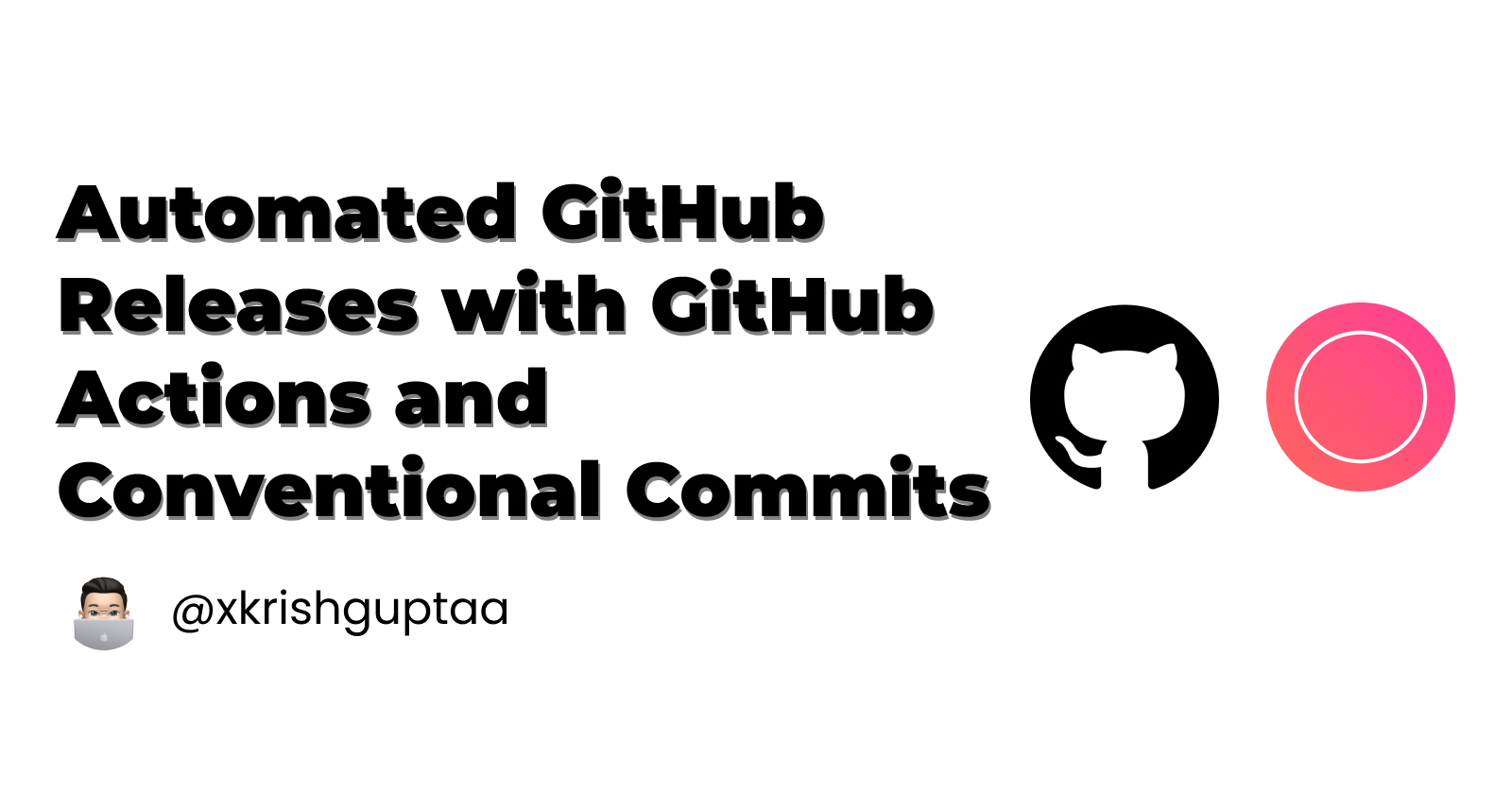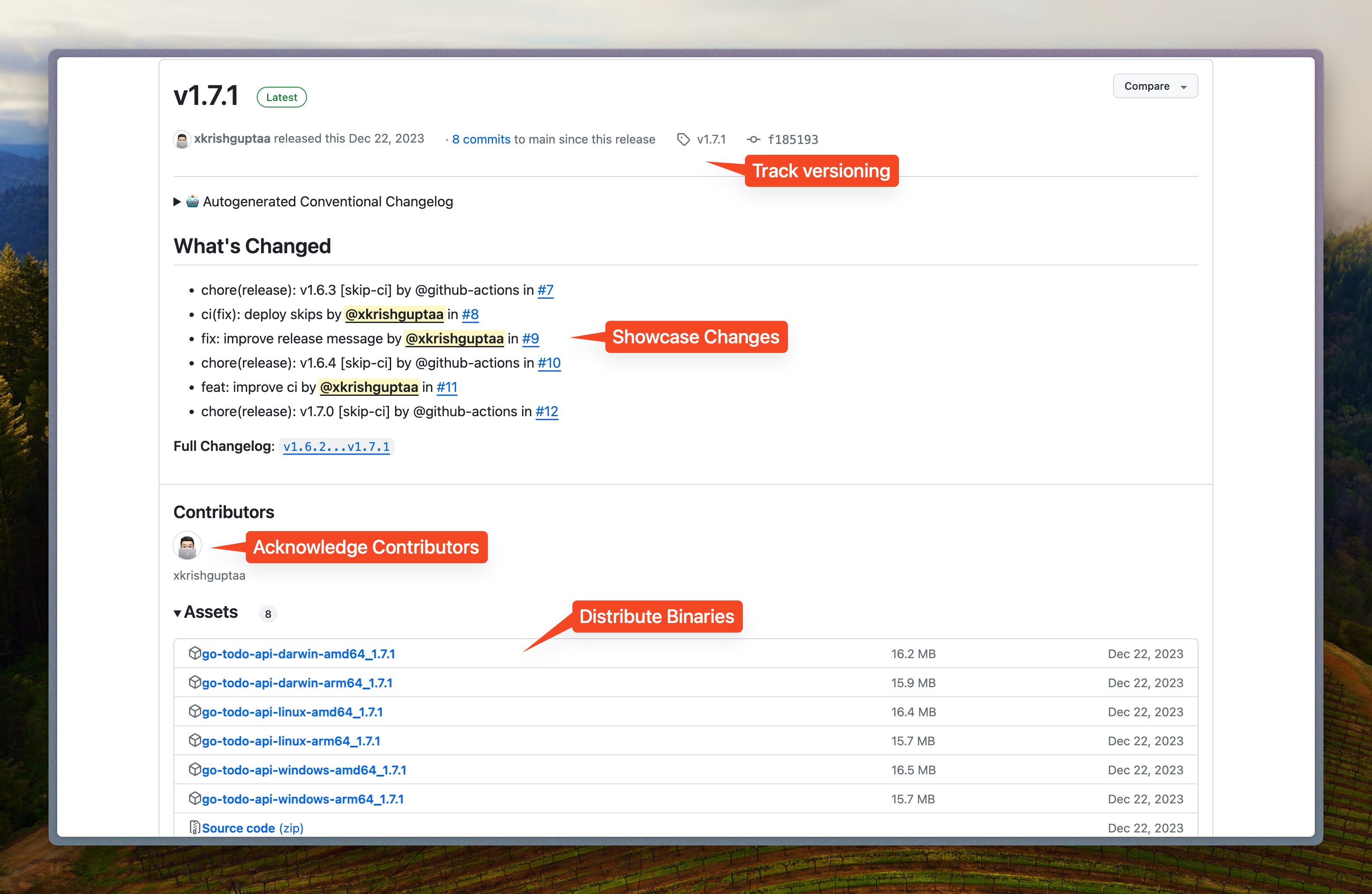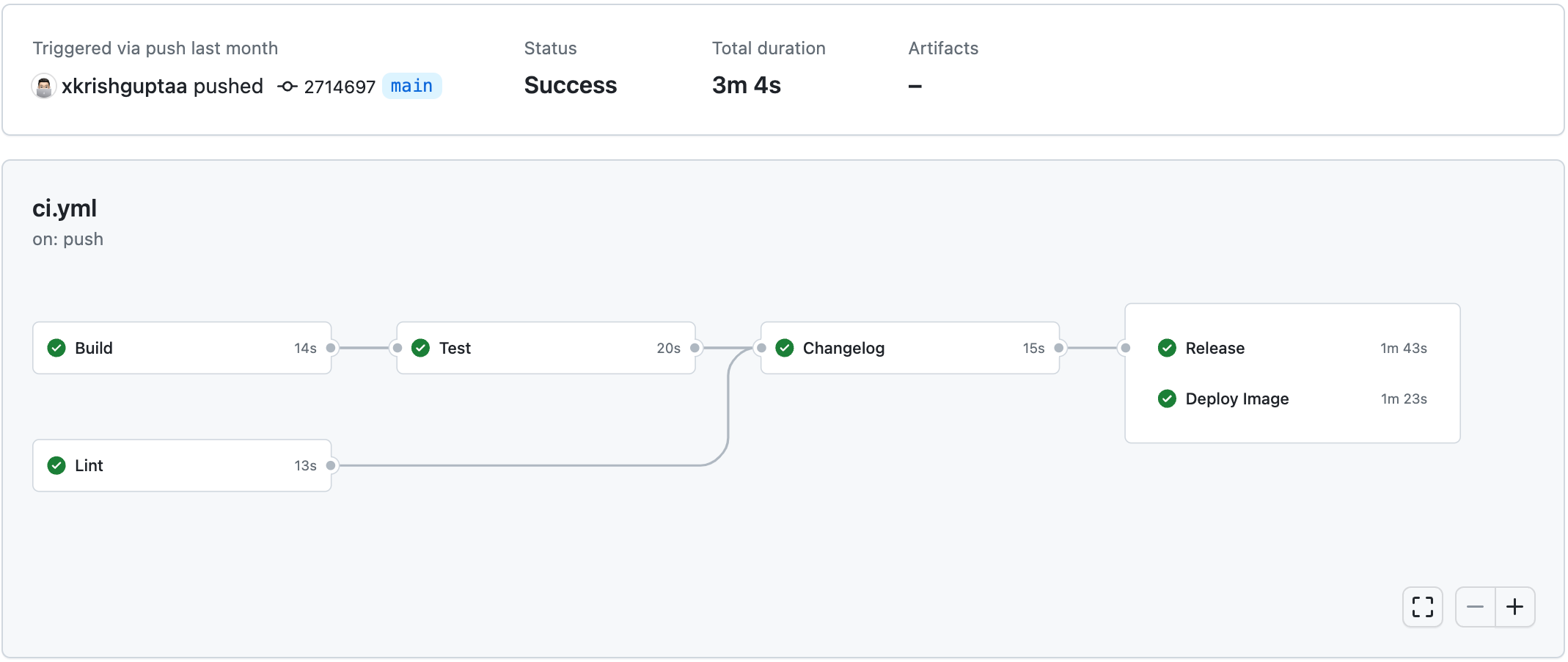Automated GitHub Releases with GitHub Actions and Conventional Commits
 Krish Gupta
Krish Gupta
Releases are a very important way to:
Track versioning
Showcase changes
Acknowledge contributors
Distribute Binaries

But, who does releases manually? That is boring. True engineers spend 6 hours automating tasks that take 6 minutes! So let's build a CI/CD Pipeline to automate this:

Problems
Let's break this problem down into smaller bits. I need to:
Check if my application works so that I don't release any broken code
Store the previous version to iterate only forwards
Figure out how I want to bump the version (spoiler: we use conventional commits)
Showcase all the commits in the release
Acknowledge the contributors by using GitHub's release template
Upload the binary assets to GitHub in the release
Check if my application works so that I don't release any broken code
Let's create a simple GitHub action that checks if my application is up to standards:
name: CI
on:
push:
branches:
- main
pull_request:
permissions:
contents: write
packages: write
pull-requests: write
env:
GO_VERSION: 1.21.3
APP_NAME: go-todo-api
jobs:
lint:
name: Lint
runs-on: ubuntu-latest
steps:
- name: Checkout
uses: actions/checkout@b4ffde65f46336ab88eb53be808477a3936bae11 # v4
- name: Setup Go
uses: actions/setup-go@0c52d547c9bc32b1aa3301fd7a9cb496313a4491 # v5
with:
go-version: ${{ env.GO_VERSION }}
- name: Install Dependencies
run: go mod download
- name: Verify Dependencies
run: go mod verify
- name: Lint ${{ env.APP_NAME }}
run: go vet ./...
build:
name: Build
runs-on: ubuntu-latest
steps:
- name: Checkout
uses: actions/checkout@b4ffde65f46336ab88eb53be808477a3936bae11 # v4
- name: Setup Go
uses: actions/setup-go@0c52d547c9bc32b1aa3301fd7a9cb496313a4491 # v5
with:
go-version: ${{ env.GO_VERSION }}
- name: Install Dependencies
run: go mod download
- name: Verify Dependencies
run: go mod verify
- name: Build ${{ env.APP_NAME }}
run: |
chmod +x ./scripts/build.sh
./scripts/build.sh
test:
name: Test
needs: build
runs-on: ubuntu-latest
steps:
- name: Checkout
uses: actions/checkout@b4ffde65f46336ab88eb53be808477a3936bae11 # v4
- name: Setup Go
uses: actions/setup-go@0c52d547c9bc32b1aa3301fd7a9cb496313a4491 # v5
with:
go-version: ${{ env.GO_VERSION }}
- name: "Warning: No test cases"
run: echo "Reminder to create test cases"
- name: Install Dependencies
run: go mod download
- name: Verify Dependencies
run: go mod verify
- name: Test ${{ env.APP_NAME }}
run: go test -v ./...
That looks like a lot of stuff, let me break it down:
We give the workflow a name:
CISet it to trigger on
pushto the main branch andpull_request(I know we only release from the pushes, but having CI for preview environments is like a bonus cherry on top)We give it some permissions, we want it to be able to:
push (
contentspermission)pull-requests(to create the pull request that will merge in the release)OPTIONAL:
packagesused to publish to the GitHub Container Registry
We create two environment variables simply to reuse them later:
GO_VERSION: If I update my go versions I don't want to go and change it everywhere, so this env variable is for standardising theGO_VERSIONAPP_NAME: This comes in handy when I want to push to dockerhub and create the binaries with proper naming! We also use it to name the steps and jobs so that they don't look like 'Linting project-name' rather than linting.
We create 3 jobs:
lint:We run
actions/checkoutSetup Go with
actions/setup-go, with our ENV variable ofGO_VERSIONreplace this with your programming languageWe install modules by running
go mod downloadandgo mod verifyWe run
go vet ./...to test the app. Replace with your test command.
build:- We duplicate the
lint, renamelinttobuildand replacego vet ./...with the build script
- We duplicate the
test:- We duplicate the
lint, renamelinttotestand replacego vet ./...with thego test -v ./...
- We duplicate the
Store the previous version to iterate only forwards
Let's create a file called package.yaml inside .github with one property called version. If you are using Node.Js then don't do it (we will use package.json instead).
Figure out how I want to bump the version
There is a specification called Conventional Commits for making commit messages both human-readable and machine-readable. The commit message is:
<type>[optional scope]: <description>
[optional body]
[optional footer(s)]
Inside 1.2.11 as the version of a software:
1is for major releases, only used when breaking changes are introduced2is for
The important thing is <type> here, if the type is one of:
feat: Feature enhancement / Minor release, if the previous version is0.2.0it becomes0.3.0fix: Bug Fix / Patch release, if the previous version is0.2.1, it bumps to0.2.2
FYI, if you get to 0.9.0 the next release will be 0.10.0 and not 1.0.0. But then how do we get to 1.0.0?
We can make a commit like feat!: breaking change to push the version to 1.0.0 or you can also do:
<type>[optional scope]: <description>
BREAKING CHANGE: update description
[optional footer(s)]
So now, we can use the tooling for conventional-commits to bump the version and showcase the changes.
Showcase all the commits in the release
We will use the TriPSs/conventional-changelog-action action for this:
changelog:
name: Changelog
needs:
- lint
- build
- test
if: github.event_name != 'pull_request'
runs-on: ubuntu-latest
outputs:
skipped: ${{ steps.changelog.outputs.skipped }}
tag: ${{ steps.changelog.outputs.tag }}
clean_changelog: ${{ steps.changelog.outputs.clean_changelog }}
version: ${{ steps.changelog.outputs.version }}
env:
PR_BRANCH: release-ci-${{ github.sha }}
steps:
- uses: actions/checkout@b4ffde65f46336ab88eb53be808477a3936bae11 # v4
- name: Create Branch
run: |
git checkout -b ${{ env.PR_BRANCH }}
- name: Create Changelog
uses: TriPSs/conventional-changelog-action@dd734f74fce61a6e02f821ee1b5930bc79a23534 # v5
id: changelog
with:
github-token: ${{ github.token }}
git-user-name: "github-actions[bot]"
git-user-email: "github-actions[bot]@users.noreply.github.com"
git-branch: ${{ env.PR_BRANCH }}
skip-git-pull: true
output-file: false
version-file: .github/package.yaml
create-summary: true
- name: Create Changelog PR
if: steps.changelog.outputs.skipped == 'false'
run: |
gh pr create --base main --head ${{ env.PR_BRANCH }} --title 'chore(release): ${{ steps.changelog.outputs.tag }} [skip-ci]' --body '${{ steps.changelog.outputs.clean_changelog }}'
env:
GH_TOKEN: ${{ github.token }}
- name: Approve Changelog PR
if: steps.changelog.outputs.skipped == 'false'
run: |
gh pr review --approve ${{ env.PR_BRANCH }}
env:
GH_TOKEN: ${{ secrets.GH_OWNER_TOKEN }}
- name: Merge Changelog PR
if: steps.changelog.outputs.skipped == 'false'
run: |
gh pr merge --squash --auto --delete-branch ${{ env.PR_BRANCH }}
env:
GH_TOKEN: ${{ secrets.GH_OWNER_TOKEN }}
Breaking it down:
We have a
changelogjob that depends onlint,buildandtestIt runs only if the event name is not
pull_requestWe have defined the outputs so that we access them in the further jobs!
We declare a
PR_BRANCHan environment variable to reuse the PR branch across all the jobsWe created the branch for the PR
git checkout -b ${{ env.PR_BRANCH }}TriPSs/conventional-changelog-actionhas all the options specified, you can look at the docs to see what they do!The only important options are
version-filewhich should bepackage.jsonfor NodeJs Users, and.github/package.yaml(the file we created) for most other users.output-fileis for changelog, I don't like having a changelog file because I can just use the GitHub Releases page to replace it.Then we create the PR to update the version
gh pr createFinally, we merge it with A SECRET called
GH_OWNER_TOKEN
This does 3 things:
Creates the
tagon GitHubMakes the PR to update the version on GitHub
Create an automated change log
The rest of the problems in bulk
Now we finally add a release job with softprops/action-gh-release
release:
name: Release
needs: changelog
if: github.event_name != 'pull_request' && needs.changelog.outputs.skipped == 'false'
runs-on: ubuntu-latest
steps:
- name: Checkout
uses: actions/checkout@b4ffde65f46336ab88eb53be808477a3936bae11 # v4
- name: Setup Go
uses: actions/setup-go@0c52d547c9bc32b1aa3301fd7a9cb496313a4491 # v5
with:
go-version: ${{ env.GO_VERSION }}
- name: Install Dependencies
run: go mod download
- name: Verify Dependencies
run: go mod verify
- name: Cross-Build ${{ env.APP_NAME }}
run: |
chmod +x ./scripts/build.sh
CROSS_BUILD=true APP_NAME=${{ env.APP_NAME }} VERSION=${{ needs.changelog.outputs.version }} ./scripts/build.sh
- name: Create Release
uses: softprops/action-gh-release@de2c0eb89ae2a093876385947365aca7b0e5f844 # v1
with:
token: ${{ secrets.GH_OWNER_TOKEN }}
tag_name: ${{ needs.changelog.outputs.tag }}
prerelease: false
draft: false
files: bin/*
generate_release_notes: true
name: ${{ needs.changelog.outputs.tag }}
body: |
<details>
<summary>🤖 Autogenerated Conventional Changelog</summary>
${{ needs.changelog.outputs.clean_changelog }}
</details>
Breaking down what we've done here:
We only execute this job
changelog.outputs.skippedis not falseWe set up to repeat all the things we did during
buildsoftprops/action-gh-releaseis being used to create the release on GitHubWe tell it the tag we get from the
changelogjobgenerate_release_notesis set to true to generate the GitHub-style release notes + it creates those cool contributor shoutoutsfilestells it which files to upload with the releasebodyuses the changelog from thechangelogstep
Let's look at the progress
This is the workflow we have right now. It builds, tests, figures out what release to make and makes a release on GitHub.
name: CI
on:
push:
branches:
- main
pull_request:
permissions:
contents: write
packages: write
pull-requests: write
env:
GO_VERSION: 1.21.3
APP_NAME: go-todo-api
jobs:
lint:
name: Lint
runs-on: ubuntu-latest
steps:
- name: Checkout
uses: actions/checkout@b4ffde65f46336ab88eb53be808477a3936bae11 # v4
- name: Setup Go
uses: actions/setup-go@0c52d547c9bc32b1aa3301fd7a9cb496313a4491 # v5
with:
go-version: ${{ env.GO_VERSION }}
- name: Install Dependencies
run: go mod download
- name: Verify Dependencies
run: go mod verify
- name: Lint ${{ env.APP_NAME }}
run: go vet ./...
build:
name: Build
runs-on: ubuntu-latest
steps:
- name: Checkout
uses: actions/checkout@b4ffde65f46336ab88eb53be808477a3936bae11 # v4
- name: Setup Go
uses: actions/setup-go@0c52d547c9bc32b1aa3301fd7a9cb496313a4491 # v5
with:
go-version: ${{ env.GO_VERSION }}
- name: Install Dependencies
run: go mod download
- name: Verify Dependencies
run: go mod verify
- name: Build ${{ env.APP_NAME }}
run: |
chmod +x ./scripts/build.sh
./scripts/build.sh
test:
name: Test
needs: build
runs-on: ubuntu-latest
steps:
- name: Checkout
uses: actions/checkout@b4ffde65f46336ab88eb53be808477a3936bae11 # v4
- name: Setup Go
uses: actions/setup-go@0c52d547c9bc32b1aa3301fd7a9cb496313a4491 # v5
with:
go-version: ${{ env.GO_VERSION }}
- name: "Warning: No test cases"
run: echo "Reminder to create test cases"
- name: Install Dependencies
run: go mod download
- name: Verify Dependencies
run: go mod verify
- name: Test ${{ env.APP_NAME }}
run: go test -v ./...
changelog:
name: Changelog
needs:
- lint
- build
- test
if: github.event_name != 'pull_request'
runs-on: ubuntu-latest
outputs:
skipped: ${{ steps.changelog.outputs.skipped }}
tag: ${{ steps.changelog.outputs.tag }}
clean_changelog: ${{ steps.changelog.outputs.clean_changelog }}
version: ${{ steps.changelog.outputs.version }}
env:
PR_BRANCH: release-ci-${{ github.sha }}
steps:
- uses: actions/checkout@b4ffde65f46336ab88eb53be808477a3936bae11 # v4
- name: Create Branch
run: |
git checkout -b ${{ env.PR_BRANCH }}
- name: Create Changelog
uses: TriPSs/conventional-changelog-action@dd734f74fce61a6e02f821ee1b5930bc79a23534 # v5
id: changelog
with:
github-token: ${{ github.token }}
git-user-name: "github-actions[bot]"
git-user-email: "github-actions[bot]@users.noreply.github.com"
git-branch: ${{ env.PR_BRANCH }}
skip-git-pull: true
output-file: false
version-file: .github/package.yaml
create-summary: true
- name: Create Changelog PR
if: steps.changelog.outputs.skipped == 'false'
run: |
gh pr create --base main --head ${{ env.PR_BRANCH }} --title 'chore(release): ${{ steps.changelog.outputs.tag }} [skip-ci]' --body '${{ steps.changelog.outputs.clean_changelog }}'
env:
GH_TOKEN: ${{ github.token }}
- name: Approve Changelog PR
if: steps.changelog.outputs.skipped == 'false'
run: |
gh pr review --approve ${{ env.PR_BRANCH }}
env:
GH_TOKEN: ${{ secrets.GH_OWNER_TOKEN }}
- name: Merge Changelog PR
if: steps.changelog.outputs.skipped == 'false'
run: |
gh pr merge --squash --auto --delete-branch ${{ env.PR_BRANCH }}
env:
GH_TOKEN: ${{ secrets.GH_OWNER_TOKEN }}
release:
name: Release
needs: changelog
if: github.event_name != 'pull_request' && needs.changelog.outputs.skipped == 'false'
runs-on: ubuntu-latest
steps:
- name: Checkout
uses: actions/checkout@b4ffde65f46336ab88eb53be808477a3936bae11 # v4
- name: Setup Go
uses: actions/setup-go@0c52d547c9bc32b1aa3301fd7a9cb496313a4491 # v5
with:
go-version: ${{ env.GO_VERSION }}
- name: Install Dependencies
run: go mod download
- name: Verify Dependencies
run: go mod verify
- name: Cross-Build ${{ env.APP_NAME }}
run: |
chmod +x ./scripts/build.sh
CROSS_BUILD=true APP_NAME=${{ env.APP_NAME }} VERSION=${{ needs.changelog.outputs.version }} ./scripts/build.sh
- name: Create Release
uses: softprops/action-gh-release@de2c0eb89ae2a093876385947365aca7b0e5f844 # v1
with:
token: ${{ secrets.GH_OWNER_TOKEN }}
tag_name: ${{ needs.changelog.outputs.tag }}
prerelease: false
draft: false
files: bin/*
generate_release_notes: true
name: ${{ needs.changelog.outputs.tag }}
body: |
<details>
<summary>🤖 Autogenerated Conventional Changelog</summary>
${{ needs.changelog.outputs.clean_changelog }}
</details>
Now we have an awesome release automation that releases every single time we push to GitHub 🚀
Bonus: Publishing to DockerHub & GHCR
If you have a Dockerfile, let's build an image and push it to DockerHub & GHCR.
deploy:
name: Deploy Image
needs: changelog
if: github.event_name != 'pull_request' && needs.changelog.outputs.skipped == 'false'
runs-on: ubuntu-latest
steps:
- name: Checkout
uses: actions/checkout@b4ffde65f46336ab88eb53be808477a3936bae11 # v4
- name: Login docker.io
uses: docker/login-action@343f7c4344506bcbf9b4de18042ae17996df046d # v3
with:
registry: docker.io
username: ${{ secrets.DOCKER_USERNAME }}
password: ${{ secrets.DOCKER_PASSWORD }}
- name: Login ghcr.io
uses: docker/login-action@343f7c4344506bcbf9b4de18042ae17996df046d # v3
with:
registry: ghcr.io
username: ${{ github.repository_owner }}
password: ${{ secrets.GH_OWNER_TOKEN }}
- name: Setup Docker Metadata
uses: docker/metadata-action@dbef88086f6cef02e264edb7dbf63250c17cef6c # v5
id: meta
with:
images: |
docker.io/${{ secrets.DOCKER_USERNAME }}/${{ env.APP_NAME }}
ghcr.io/${{ github.repository_owner }}/${{ env.APP_NAME }}
tags: |
latest
${{ needs.changelog.outputs.version }}
${{ github.sha }}
- name: Build and Push Docker Image
uses: docker/build-push-action@4a13e500e55cf31b7a5d59a38ab2040ab0f42f56 # v5
with:
context: .
push: true
tags: ${{ steps.meta.outputs.tags }}
labels: ${{ steps.meta.outputs.labels }}
We created a deploy job in the workflow, here is what it does:
Once we have successfully made the release
We authenticate to 2 Docker Registries using the official
docker/login-actionUsing
docker/metadata-actionwe set up metadata of the action, including:Image name, we define the image name using
APP_NAMEvariable we declared earlier for both the docker hub andghcr.We set three tags for each of the images:
latest, the version of the release and the SHA of the commit
Finally, we build and push to the registries using the
docker/build-push-actionwith the Dockerfile in the root of the repository.
Here's the source code for the workflow file, and this is an example run.
Follow Kubesimplify on Hashnode, Twitter and LinkedIn. Join our Discord server to learn with us.
Subscribe to my newsletter
Read articles from Krish Gupta directly inside your inbox. Subscribe to the newsletter, and don't miss out.
Written by
